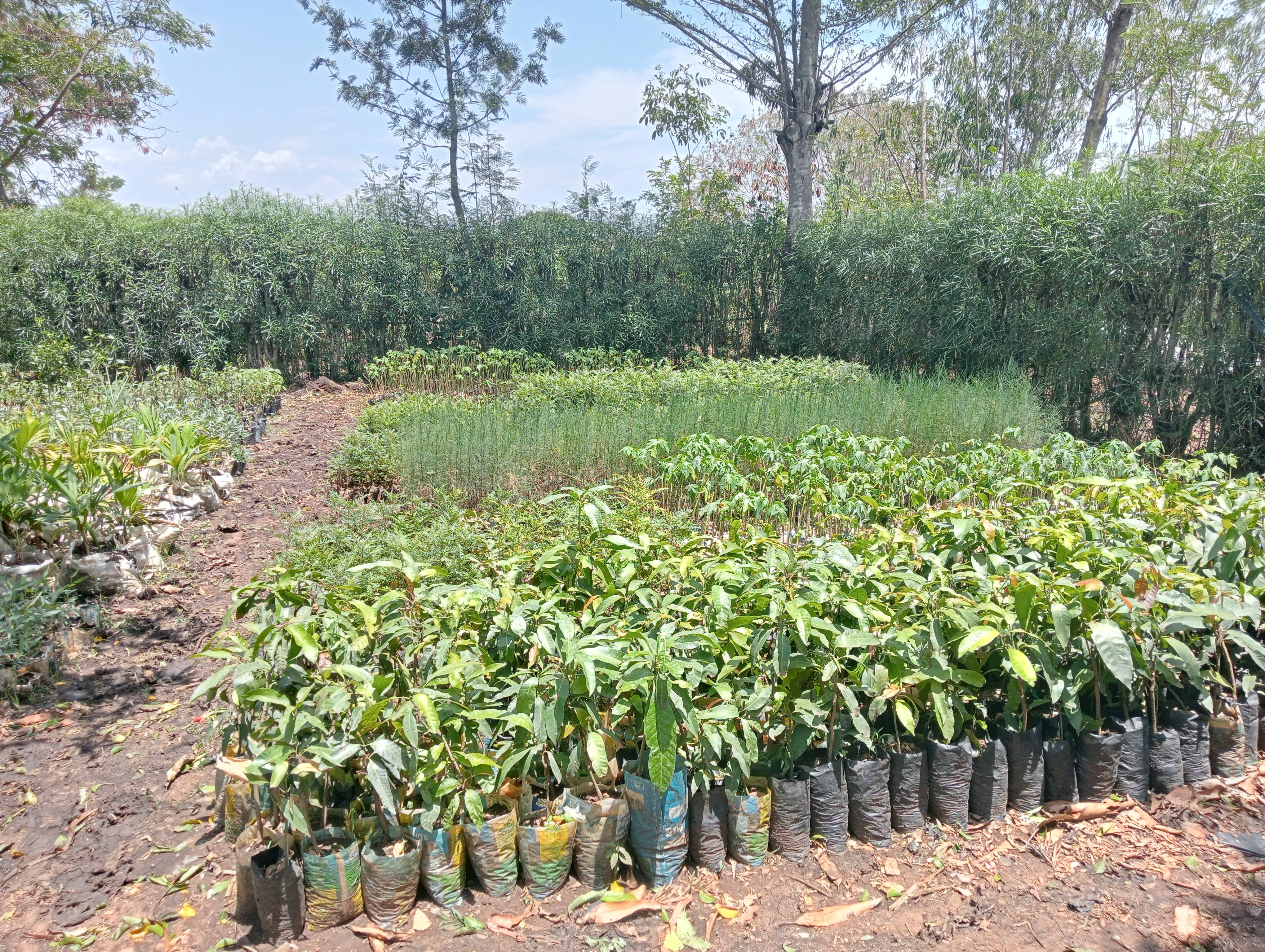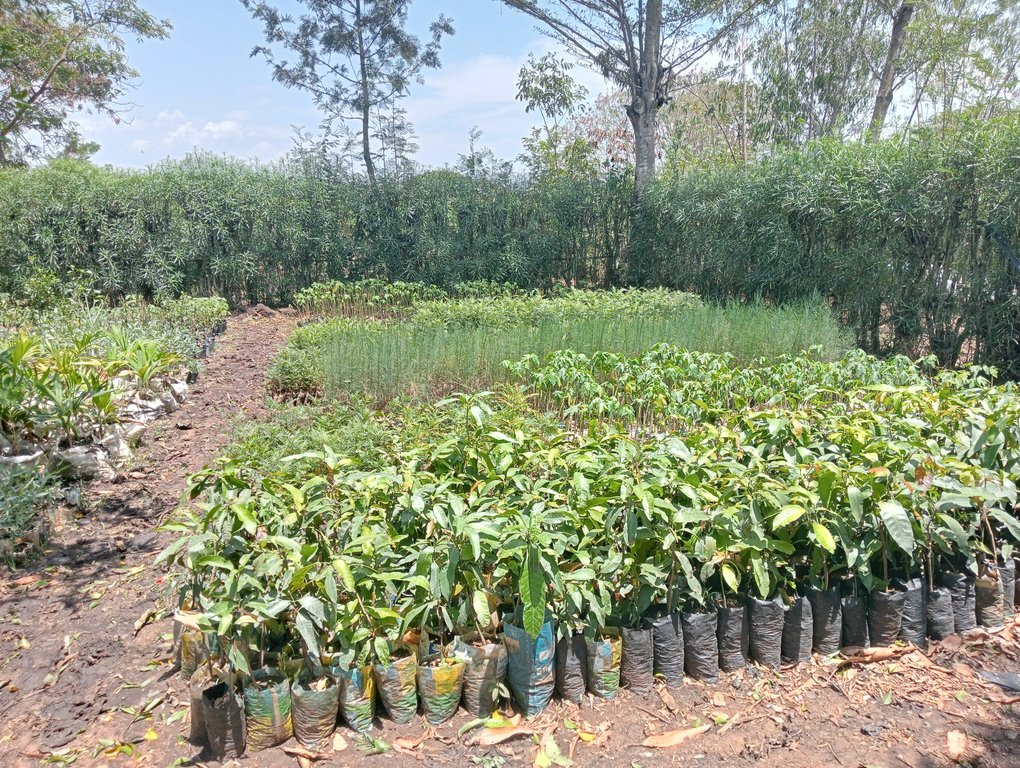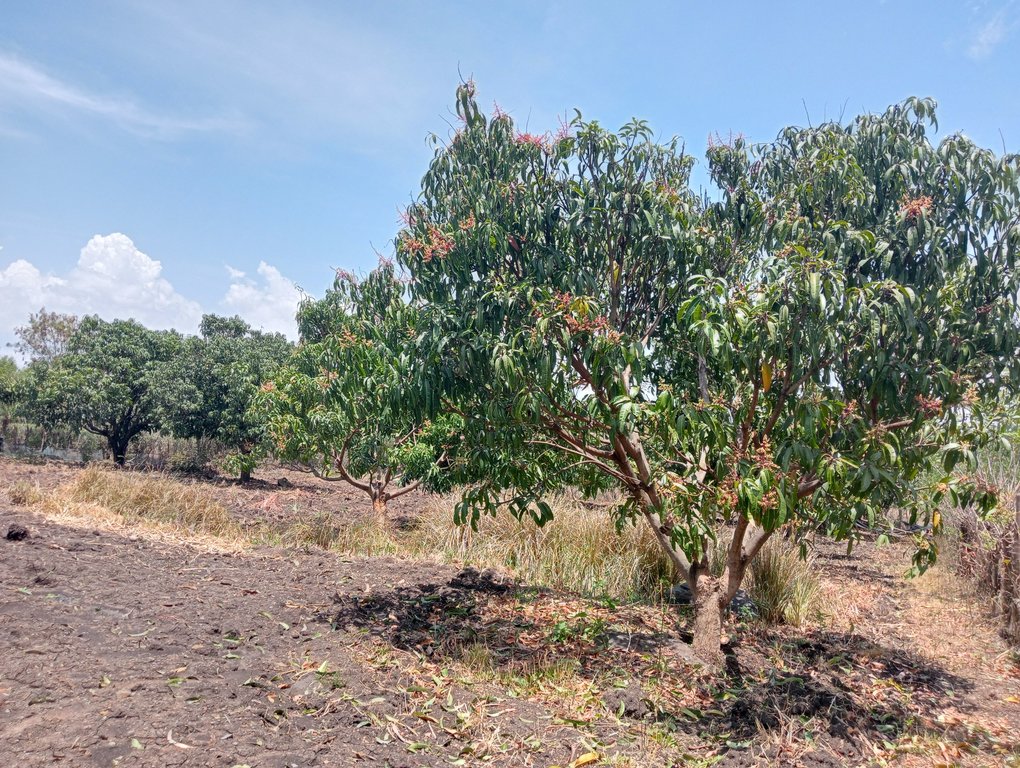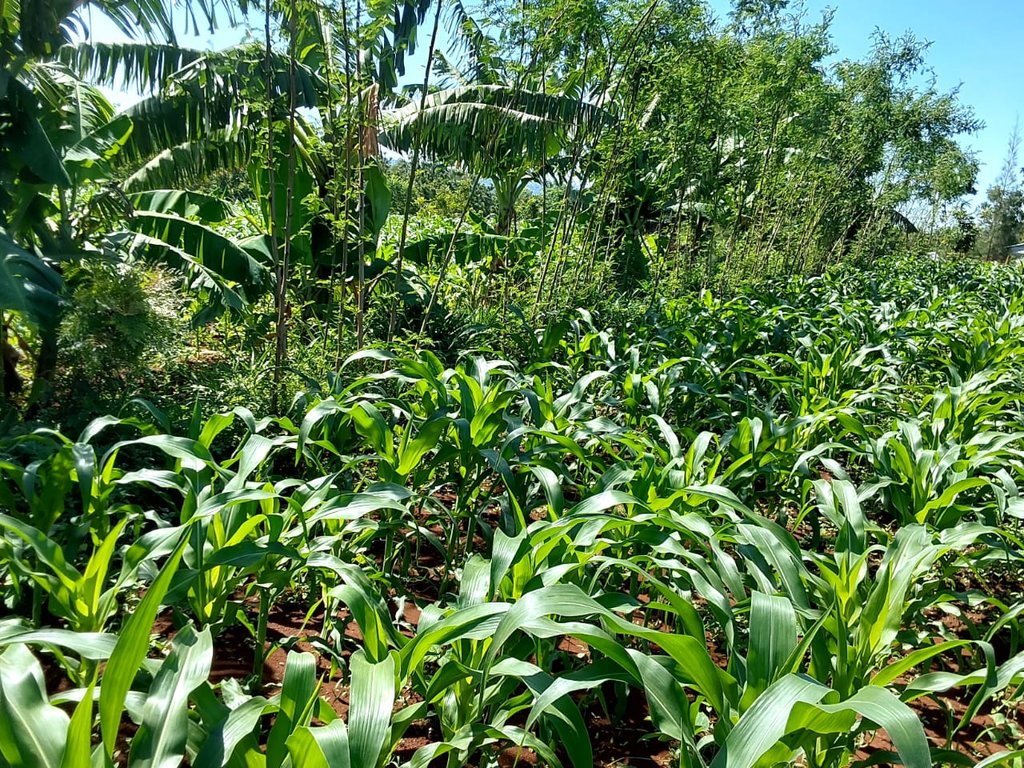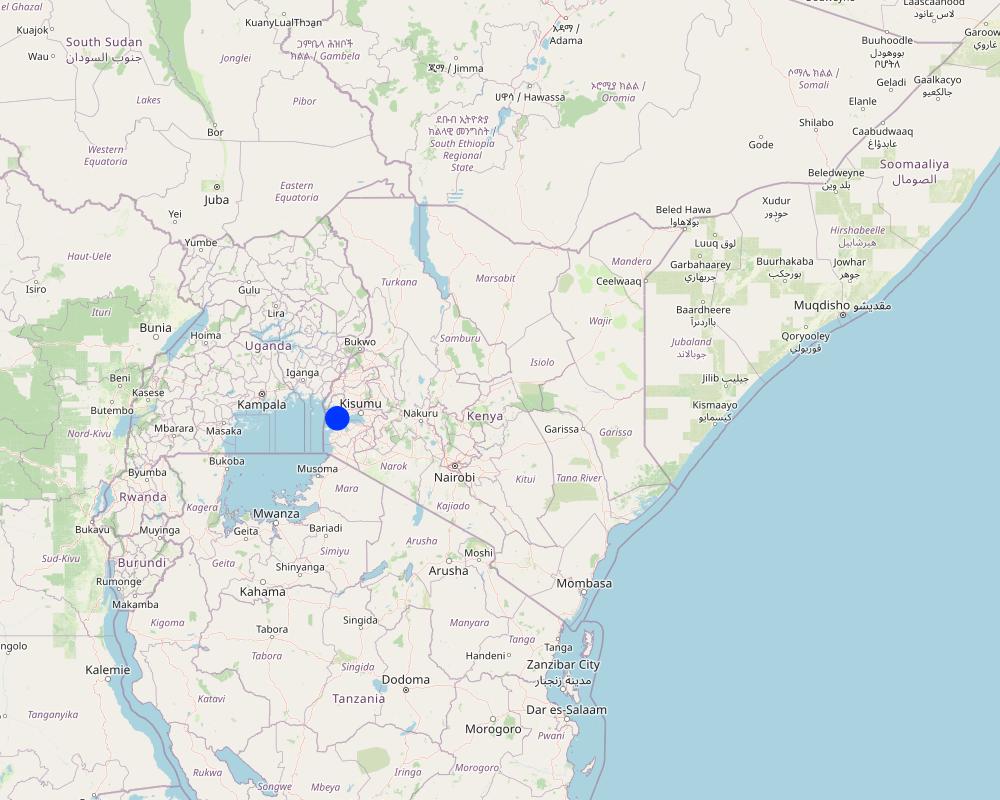Promotion of different trees for agroforestry [Kenya]
- Creation:
- Update:
- Compiler: William Akwanyi
- Editors: JARED AYIENA, Innocent Faith, Noel Templer, JUSTINE OTSYULA, Tabitha Nekesa, Ahmadou Gaye, Siagbé Golli
- Reviewers: William Critchley, Rima Mekdaschi Studer, Sally Bunning
approaches_6706 - Kenya
View sections
Expand all Collapse all1. General information
1.2 Contact details of resource persons and institutions involved in the assessment and documentation of the Approach
Key resource person(s)
land user:
Omolo Charles Abok
+254 728 135152
charlesabok88@gmail.com
Welthungerhilfe farmer
Village of Nyaguda, South Sakwa ward, Bondo Sub-county, Siaya County
Kenya
SLM specialist:
SLM specialist:
Name of project which facilitated the documentation/ evaluation of the Approach (if relevant)
Soil protection and rehabilitation for food security (ProSo(i)l)Name of the institution(s) which facilitated the documentation/ evaluation of the Approach (if relevant)
Deutsche Gesellschaft für Internationale Zusammenarbeit (GIZ)Name of the institution(s) which facilitated the documentation/ evaluation of the Approach (if relevant)
Alliance Bioversity and International Center for Tropical Agriculture (Alliance Bioversity-CIAT) - Kenya1.3 Conditions regarding the use of data documented through WOCAT
When were the data compiled (in the field)?
01/03/2023
The compiler and key resource person(s) accept the conditions regarding the use of data documented through WOCAT:
Yes
1.4 Reference(s) to Questionnaire(s) on SLM Technologies
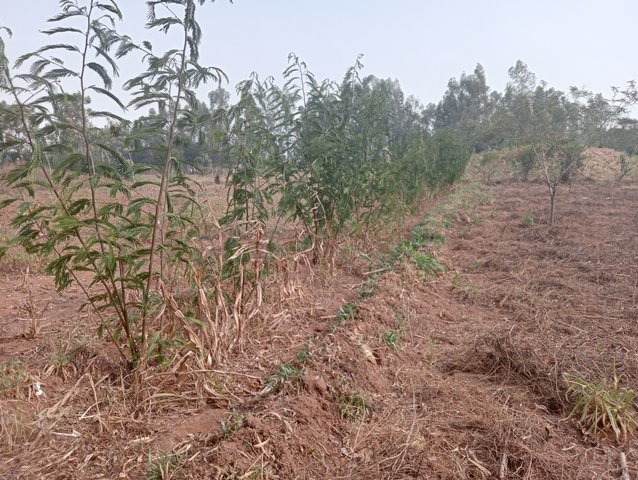
Vegetative cross-slope barriers [Kenya]
Cross-slope barriers in the form of vegetative strips are established on sloping lands to reduce runoff velocity and prevent soil loss, thereby contributing to the conservation of soil, water, and plant nutrients.
- Compiler: William Akwanyi
2. Description of the SLM Approach
2.1 Short description of the Approach
Promoting the values of different trees and their benefits in agroforestry contributes to increased adoption by farmers.
2.2 Detailed description of the Approach
Detailed description of the Approach:
Agroforestry involves the integration of trees and/ or shrubs in a farming system on the same land where crops or pastures are grown. It offers significant environmental, economic, and social benefits. Agroforestry also enables farmers to diversify their on-farm income. Furthermore, it contributes to climate change adaptation and mitigation and improves the environment within the farm, especially soils. However, not every farmer is willing to adopt agroforestry. Trees and shrubs take up space that would have been dedicated to crops or pasture: this is a primary reason why farmers are not willing to plant trees and/ or shrubs on their farms. Similarly, many farmers do not clearly understand the values of some trees and shrubs. It is, therefore, essential to overcome the barriers to adopting agroforestry among farmers.
The ProSoil project has created awareness among farmers in Kakamega, Bungoma, and Siaya Counties about the more efficient and profitable tree and shrub-based value chains to attract farmers to agroforestry and pave the way for greater uptake. The farmers were targeted through their groups. Each group consisting of about 25 farmers, and with at least 30% women. Farmers are introduced to trees and/ or shrubs that blend well with their farming system. In addition, farmers choose trees and/ or shrubs based on the sizes of their farming land and their respective benefits. Farmers can plant trees and shrubs as single stands or integrate them into farming land. They can also plant agroforestry trees around their homesteads. A single stand can have, for example, mangos, avocados, and/or other trees. The project advocates for a more sustainable win-win approach where farmers and the environment benefit from an agroforestry system. Some of the benefits of trees and shrubs, as highlighted by the project, include the following:
a) Soil erosion control: trees and shrubs are planted on across slopes to slow down runoff and trap sediment (consequently, accumulating soil – this can form terraces after several years). Their roots hold the soil in place and reduce the impact of moving water.
b) Stabilising stream banks and gullies (e.g., Leucaena leucocephala, Sesbania grandiflora, Moringa oleifera, etc.): help to reduce soil erosion along streams and gullies when planted at the medium- to high-level watermark. Their roots hold the soil in place and reduce the impact of moving water.
c) Green manure (e.g., Sesbania sesban, Tithonia sp., etc.): from foliage and twigs.
d) Live fences (e.g., Tithonia sp.): used as boundaries to provide privacy and protection from browsing animals.
e) Windbreakers (e.g., Casuarina equisetifolia, Grevillea robusta, Leucaena leucocephala, etc.): planted in one or two rows/ lines closely together along the edges of the farm and perpendicular to winds to protect crops, soils, and structures from the detrimental effects of wind.
f) Fodder (e.g., Grevillea robusta, Sesbania sesban, Leucaena leucocephala, etc.): foliage is food for livestock.
g) Food (e.g., mangoes, avocadoes, etc.): a human food source.
h) Carbon sequestration (all trees and shrubs): they act as carbon sinks by capturing carbon dioxide from the atmosphere.
2.3 Photos of the Approach
2.5 Country/ region/ locations where the Approach has been applied
Country:
Kenya
Region/ State/ Province:
Siaya County, Nyanza Region
Further specification of location:
Nyagudha village, South Sakwa Ward, Bondo Sub-county
Map
×2.6 Dates of initiation and termination of the Approach
Indicate year of initiation:
2019
2.7 Type of Approach
- Both traditional practice and project based: farmers have been growing trees and shrubs on their farms but the ProSoil project introduced them to more beneficial trees and better ways of producing the trees e.g., through grafting.
2.8 Main aims/ objectives of the Approach
Aim: To promote the adoption of agroforestry.
Objectives:
1) To introduce farmers to the diverse benefits of trees in farming.
2) To encourage farmers to incorporate trees and/ or shrubs in their farming.
2.9 Conditions enabling or hindering implementation of the Technology/ Technologies applied under the Approach
social/ cultural/ religious norms and values
- enabling
Trees play a central role in the socio-cultural lives of people and are used for a wide range of cultural practices.
- hindering
Cultural beliefs: e.g., women are not supposed to plant (some) trees as this is considered a male role. This hinders women from full participation in agroforestry activities.
availability/ access to financial resources and services
- hindering
Some farmers do not have adequate financial resources to purchase seedling of some tree and shrub seedlings.
collaboration/ coordination of actors
- enabling
Other institutions such as the county governments pass agroforestry information to farmers through the public agricultural extension officers. County governments are important collaborators in the ProSoil project.
legal framework (land tenure, land and water use rights)
- hindering
Trees and/ or shrubs take several years to mature. This is closely linked to land tenure since most people would prefer to establish trees only on their farms.
policies
- enabling
Kenya's 10 Percent Tree Cover Strategy includes the component of promoting farm forestry through various platforms e.g., radio and TV.
land governance (decision-making, implementation and enforcement)
- hindering
Women and youth have little or no control over land in most communities. Hence, they cannot make decisions to plant (some) trees on the family land.
knowledge about SLM, access to technical support
- enabling
ProSoil project has supported the dissemination of information about the importance of agroforestry as an SLM technology and how to propagate trees e.g., through grafting. As a result, some farmers have established trees nurseries.
markets (to purchase inputs, sell products) and prices
- enabling
The increasing awareness about the benefits of many trees has led to an increase in the demand for the different products from the trees e.g., fruits, honey, medicines, etc. This potential of trees to generate income encourages farmers to plant trees.
3. Participation and roles of stakeholders involved
3.1 Stakeholders involved in the Approach and their roles
- local land users/ local communities
Farmers, farmer groups (women, youth, and mixed gender)
Recipients of the trainings in agroforestry.
- SLM specialists/ agricultural advisers
GIZ ProSoil project SLM specialists; specialists from the implementing partner, Welthungerhilfe; and county SLM specialists from the departments of agriculture and environment.
Provides technical advice to the farmers and link farmers to markets and tree nurseries.
- local government
County government agriculture and environment departments
Provides technical advice to the farmers and link farmers to markets and tree nurseries.
- international organization
GIZ
Financial support to the technical team and farmers during capacity building.
If several stakeholders were involved, indicate lead agency:
GIZ
3.2 Involvement of local land users/ local communities in the different phases of the Approach
| Involvement of local land users/ local communities | Specify who was involved and describe activities | |
|---|---|---|
| initiation/ motivation | self-mobilization | Farmers involved in the training in agroforestry. |
| planning | interactive | Farmers consulted on where and when to establish demos of agroforestry tree nurseries. |
| implementation | self-mobilization | Although farmers are advised which trees are better for their farms, they are the final decision makers on which trees and shrubs to incorporate in their farms. |
| monitoring/ evaluation | passive | Interviews with implementing farmers. |
| none |
3.3 Flow chart (if available)
Description:
The ProSoil project (GIZ and WHH) provides financial (transport reimbursement) and material (seedlings) support to farmers through their groups (Ndati Development Self-Help Group). The project also facilitates the county departments of Agriculture and Environment to train farmers in agroforestry and increase their awareness about the socio-economic and ecological benefits of different trees. at the farm.
Author:
William Akwanyi
3.4 Decision-making on the selection of SLM Technology/ Technologies
Specify who decided on the selection of the Technology/ Technologies to be implemented:
- mainly land users, supported by SLM specialists
Explain:
The ProSoil project team provides technical support on the selection of trees based on the diverse needs of farmers, and the sizes and locations of their farms. However, the final decision to plant which type(s) of trees and where to plant them at the farm rests with the farmer.
Specify on what basis decisions were made:
- evaluation of well-documented SLM knowledge (evidence-based decision-making)
- personal experience and opinions (undocumented)
4. Technical support, capacity building, and knowledge management
4.1 Capacity building/ training
Was training provided to land users/ other stakeholders?
Yes
Specify who was trained:
- land users
Form of training:
- farmer-to-farmer
- demonstration areas
Subjects covered:
1. Different trees in agroforestry and their benefits
2. Tree nursery management
3. Grafting
4. Agroforestry systems
5. Value addition to agroforestry products and marketing
Comments:
Welthungerhilfe contracted SLM specialists from the county departments of agriculture and environment to train farmers and carry out demonstrations on tree planting and value addition in their groups during sessions organized by the ProSoil project. Other farmers are learning from the trained farmers. These specialists also advice farmers during farm visits.
4.2 Advisory service
Do land users have access to an advisory service?
Yes
Specify whether advisory service is provided:
- on land users' fields
- at permanent centres
- Specific locations where the farmers interact with the technical officers and at their farms.
Describe/ comments:
Farmers were trained in their groups at specific venues during sessions organized by the ProSoil project/ WHH. Other farmers are learning from the trained farmers. These specialists also advice farmers during farm visits.
4.3 Institution strengthening (organizational development)
Have institutions been established or strengthened through the Approach?
- yes, a little
Specify the level(s) at which institutions have been strengthened or established:
- local
Describe institution, roles and responsibilities, members, etc.
Farmers have formed groups such as Ndati Development Self-Help Group e.g., to run tree nurseries. The groups consist of several men and women of diverse ages. Farmers develop funding and other support proposals through the groups.
Specify type of support:
- capacity building/ training
- equipment
Give further details:
Trainings in agroforestry, markets, tree propagation, etc.
Nursery materials and equipment including water tanks, seeds and grafting tools
4.4 Monitoring and evaluation
Is monitoring and evaluation part of the Approach?
Yes
Comments:
GIZ and Welthungerhilfe regularly follows up with farmers to check on the implementation of technologies promoted under this approach.
If yes, is this documentation intended to be used for monitoring and evaluation?
No
Comments:
This documentation in intended for keeping a record of SLM technologies and approaches.
4.5 Research
Was research part of the Approach?
No
5. Financing and external material support
5.1 Annual budget for the SLM component of the Approach
If precise annual budget is not known, indicate range:
- 10,000-100,000
Comments (e.g. main sources of funding/ major donors):
ProSoil project facilitated trainings on the SLM technologies under this approach, including transport reimbursement to farmers and trainers and remuneration to trainers during trainings. Farmers meet the costs of land preparation, acquiring seeds and seedlings, planting trees, and managing the trees. The stated budget is for training one farmer group of about 25 farmers.
5.2 Financial/ material support provided to land users
Did land users receive financial/ material support for implementing the Technology/ Technologies?
Yes
If yes, specify type(s) of support, conditions, and provider(s):
The ProSoil project through Welthungerhilfe supported the farmers (through their group) with trainings and setting up demo plots.
5.3 Subsidies for specific inputs (including labour)
- none
If labour by land users was a substantial input, was it:
- voluntary
Comments:
Farmers voluntarily provided labour at the demonstration plot and on their own land.
5.4 Credit
Was credit provided under the Approach for SLM activities?
No
5.5 Other incentives or instruments
Were other incentives or instruments used to promote implementation of SLM Technologies?
Yes
If yes, specify:
Linkage to markets for the tree and shrub products. GIZ, WHH, and the county department of agriculture and environmental invite farmers to field days where the farmer can link up with potential markets.
6. Impact analysis and concluding statements
6.1 Impacts of the Approach
Did the Approach empower local land users, improve stakeholder participation?
- No
- Yes, little
- Yes, moderately
- Yes, greatly
Farmers were empowered with skill on how to propagate trees. Stakeholder participation was enhanced through collaboration with other actors such as the county government.
Did the Approach enable evidence-based decision-making?
- No
- Yes, little
- Yes, moderately
- Yes, greatly
Farmers were motivated to plant some trees and shrubs on their farms after benchmarking farms which had established and benefited from similar trees.
Did the Approach help land users to implement and maintain SLM Technologies?
- No
- Yes, little
- Yes, moderately
- Yes, greatly
After learning about the importance of different trees, farmers incorporated trees in their farming systems e.g., planting trees and/ or shrubs in vegetative cross slope barriers.
Did the Approach improve knowledge and capacities of land users to implement SLM?
- No
- Yes, little
- Yes, moderately
- Yes, greatly
The trainings given to farmers included how to plant different trees and areas within a farm setting where such trees are best suited. This knowledge was helpful in the incorporation of trees in the implementation of vegetative cross-slope barriers, green manure cover crops, and retention ditches.
Did the Approach mitigate conflicts?
- No
- Yes, little
- Yes, moderately
- Yes, greatly
Planting of quick growing shrubs has provided source of fuel wood at the household level reducing conflicts resulting in neighbouring farmers invading farms for fuel wood
Did the Approach lead to improved food security/ improved nutrition?
- No
- Yes, little
- Yes, moderately
- Yes, greatly
Some of the agroforestry trees promoted under the different technologies and for which this approach sought to create awareness about are sources of food.
Did the Approach improve access to markets?
- No
- Yes, little
- Yes, moderately
- Yes, greatly
The trainings include linking farmers to market for some of the agroforestry products.
Did the Approach improve the capacity of the land users to adapt to climate changes/ extremes and mitigate climate related disasters?
- No
- Yes, little
- Yes, moderately
- Yes, greatly
Some of the trees are sources of food during months when there is scarcity of food e.g., mangoes mature mostly during the dry season when there is scarcity of food in the households.
Did the Approach lead to employment, income opportunities?
- No
- Yes, little
- Yes, moderately
- Yes, greatly
Some farmers have established tree nurseries. They sell tree seedlings to earn income. Some have employed tree nursery operators.
6.2 Main motivation of land users to implement SLM
- increased production
Some of the trees and shrubs promoted e.g., sesbania improve soil through nitrogen fixation. Hence, they increase soil productivity and consequently crop and livestock production.
- increased profit(ability), improved cost-benefit-ratio
Most trees do not require costly implementation activities, yet they have multiple uses at the farm, including sources of products e.g., fruits that can be sold to earn income. This increased the profitability of the farm. This reduces the costs incurred at the farm against the benefits accrued.
- reduced land degradation
Trees reduce soil erosion and formation of gullies. They also add nutrients to the soil.
- reduced risk of disasters
Trees reduce the flow of runoff and increase the infiltration of water into the soil. Such water would have otherwise caused flooding downstream. they also act as windbreakers reducing damage on farms.
- environmental consciousness
Farmers understand the importance of trees in environmental management. They have planted trees - trees conserve the environment.
- enhanced SLM knowledge and skills
Farmers have enhanced their knowledge in agroforestry, including tree nursery management. They also capacity build other farmers.
- aesthetic improvement
Farmers have planted trees that have beautified their homes and farms.
6.3 Sustainability of Approach activities
Can the land users sustain what has been implemented through the Approach (without external support)?
- yes
If yes, describe how:
Farmers have established group tree nurseries as sources of seedlings and income. Some of the trees promoted under this approach can easily be propagated by farmers.
6.4 Strengths/ advantages of the Approach
| Strengths/ advantages/ opportunities in the land user’s view |
|---|
| Trees contribute to environmental management - increase in carbon sequestration (capture of carbon dioxide), control of soil erosion, and conservation of water. |
| Trees have multiple products, including food, humus, timber, firewood, etc. |
| Most trees do not require costly and tedious maintenance. |
| Strengths/ advantages/ opportunities in the compiler’s or other key resource person’s view |
|---|
| Trees can be planted at the homestead. Hence, an added value of the homestead. |
| The benefits of trees go beyond the farm and the farmer e.g., beauty which is enjoyed by anyone who looks at the trees. |
6.5 Weaknesses/ disadvantages of the Approach and ways of overcoming them
| Weaknesses/ disadvantages/ risks in the land user’s view | How can they be overcome? |
|---|---|
| Tree seedlings require a lot of manure and proper care to protect them from animals. | Farmers to make their own compost at the farm. |
| Some seedlings are expensive. | Increase awareness among farmers about seed preparation and tree nursery management. |
| Weaknesses/ disadvantages/ risks in the compiler’s or other key resource person’s view | How can they be overcome? |
|---|---|
| Trees can take up land that would have been used for food production. | Proper planning of the farm. |
7. References and links
7.1 Methods/ sources of information
- field visits, field surveys
One field visit to the land user.
- interviews with land users
One on-farm interview and follow-up calls with the land user.
- interviews with SLM specialists/ experts
Interview with Welthungerhilfe SLM specialist and several follow-up calls.
- compilation from reports and other existing documentation
Online literature sources reviewed.
7.2 References to available publications
Title, author, year, ISBN:
Extension Approaches to Promote Effective Adoption of Agroforestry Practices: Lessons Learned from Indonesia
Available from where? Costs?
Free download at http://apps.worldagroforestry.org/downloads/Publications/PDFS/PO19073.pdf
7.3 Links to relevant information which is available online
Title/ description:
Paving the way for greater uptake of agroforestry farming systems
URL:
https://www.niras.com/news/promoting-agroforestry-in-the-development-context/#:~:text=Agroforestry%20involves%20the%20integration%20of,dependent%20on%20a%20single%20crop.
Links and modules
Expand all Collapse allLinks

Vegetative cross-slope barriers [Kenya]
Cross-slope barriers in the form of vegetative strips are established on sloping lands to reduce runoff velocity and prevent soil loss, thereby contributing to the conservation of soil, water, and plant nutrients.
- Compiler: William Akwanyi
Modules
No modules


